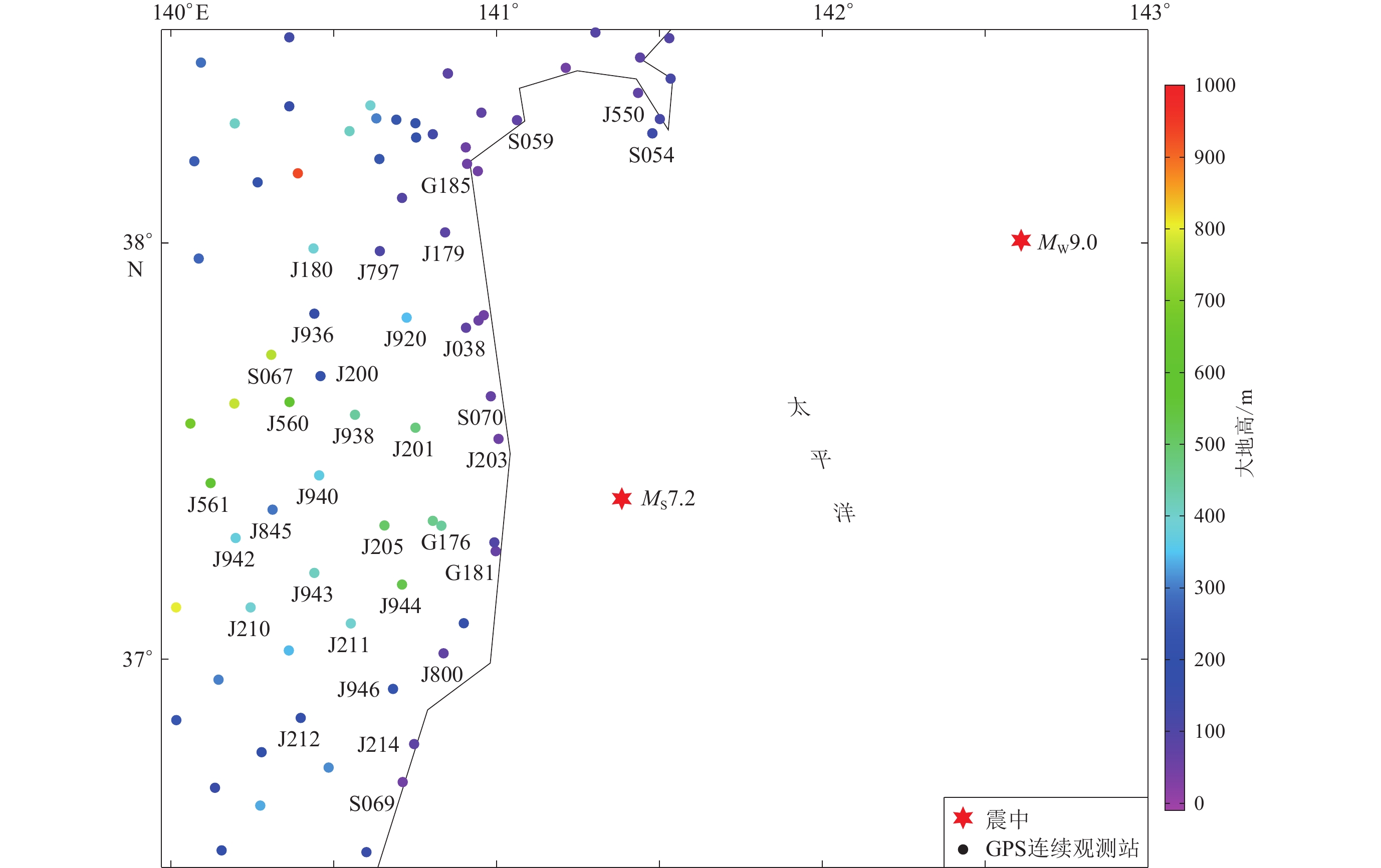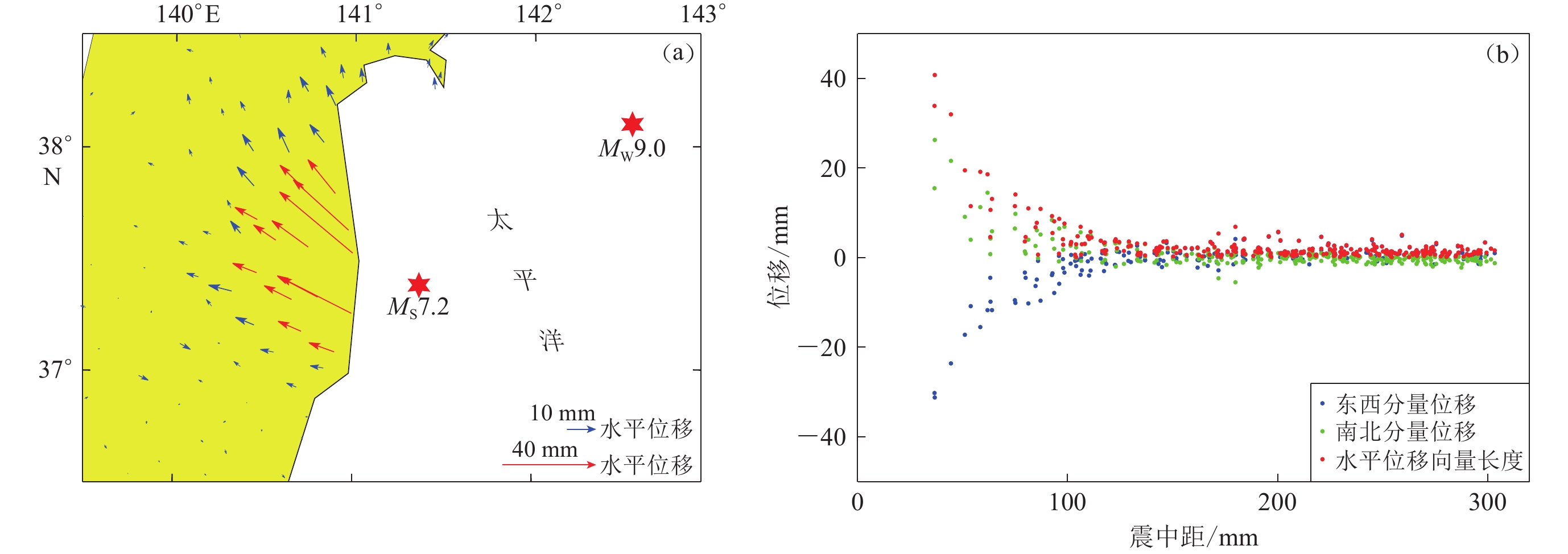Crustal movements of the eastern Honshu offshore MS7.2 earthquake in Japan in 2016
-
摘要:
2016年11月22日日本本州东岸近海发生东日本MW9.0大地震的MS7.2强余震。本文利用美国内华达大学内华达大地测量实验室网站获得此次大地震周围共30多个GPS连续观测站及其它台站的IGS08全球参考框架坐标时间序列,采用北京附近的GPS连续观测站BJSH作为区域位移参考框架的核心站,获取了此次MS7.2强余震的同震水平位移和区域参考框架位移时间序列,得到了此次强余震前后的位移时空变化图像。结果显示:尽管本州东岸近海MS7.2地震作为东日本MW9.0地震的强余震,受其震后形变的影响强烈,但其地壳水平形变的前兆规律与已观测到的大地震一致;不同的是东日本MW9.0地震前的垂直位移无积累,而本州东岸近海MS7.2地震前后的垂直位移保持MW9.0地震后均匀而缓慢的衰减变化;临震前震中附近的GPS连续观测站的东西分量明显减速,有的甚至减至零,是明显的短期前兆异常。此外,本文还进一步讨论了两种同震位移及其成因,并推断地壳水平运动挤压是此次地震的成因。
-
关键词:
- GPS /
- GNSS /
- 地震前兆 /
- 2016年日本本州东岸近海MS7.2强余震 /
- 同震位移
Abstract:In Japan, on November 22, 2016, occurred the eastern Honshu offshore MS7.2 earthquake, which was the aftershock of the 2011 Tohoku MW9.0 earthquake. Time series of coordinates of a large number of GPS stations in the world are available at the website of the Nevada Geodetic Laboratory of the Nevada University. Based on the time series of coordinates in the global reference frame of IGS08 at more than 30 stations of continuous GPS observations, downloaded from the website and with the station of continuous GPS observation BJSH near Beijing used as the core station in the regional reference frame, the coseismic displacements and time series of horizontal displacements before and after the earthquake are analyzed in time and space. The results show, though the eastern Honshu offshore MS7.2 earthquake, as the aftershock of the 2011 Tohoku MW9.0 earthquake, was intensely affected by the postseismic crustal deformation of the main shock, the precursory horizontal deformations were in good agreement with those of other large earthquakes. The prominent feature of the Tohoku earthquake is that there was no significant preseismic vertical displacement accumulation, whereas the vertical displacements before and after the eastern Honshu offshore MS7.2 earthquake show slow and uniform decaying as those after the main shock. Shortly before the earthquake, the stations of continuous GPS observations near the epicenter showed significant decrease in velocities or even zero as for the east component, which were short term precursory anomalies. Moreover, two types of coseismic displacements and their cause were discussed, and the horizontal compression in the crust was the cause of the aftershock.
-
-
图 3 2016年11月22日(1924GPS周,周二)本州东岸近海MS7.2强余震前后GPS观测站J203的水平位移向量时间序列(a)和位移分量时间序列(b)
Figure 3. Time series of the horizontal displacement vectors (a) and three components displacement at the station J203 (37 km away from the epicenter) of continuous GPS observation before and after the eastern Honshu offshore MS7.2 strong aftershock on November 22,2016 (Tuesday of GPS week 1924)
图 6 2015年4月25日(1841GPS周,周六)尼泊尔MS8.1地震前后距离震中60 km的GPS连续观测站CHLM位移三分量及同震水平位移向量时间序列
Figure 6. Time series of displacement components and the horizontal displacement vector at the station CHLM of continuous GPS observation,60 km away from the epicenter,before and after the Nepal earthquake of MS8.1 on April 25,2015 (Saturday of GPS week 1841)
-
顾国华,王武星,孟国杰,徐岳仁. 2009. GPS 测得的汶川大地震前后的地壳运动[J]. 武汉大学学报(信息科学版),34(11):336–1339. Gu G H,Wang W X,Meng G J,Xu Y R. 2009. Crustal movements before and after the Wenchuan earthquake as detected by GPS observations[J]. Geomatics and Information Science of Wuhan University,34(11):1336–1339 (in Chinese).
顾国华. 2012. GPS: 地震预测利器[M], 北京: 北京大学出版社: 130−150. Gu G H. 2012. GPS: Useful Technique for Earthquake Prediction[M]. Beijing: Peking University Press: 130−150 (in Chinese).
顾国华,王武星,占伟,梁洪宝,朱爽. 2015. 东日本MW9.0大地震前、同震及震后地壳水平运动[J]. 武汉大学学报(信息科学版),40(12):1669–1676. Gu G H,Wang W X,Zhan W,Liang H B,Zhu S. 2015. Preseismic,coseismic and postseismic horizontal crustal movements of the MW9.0 Tohoku earthquake in Japan[J]. Geomatics and Information Science of Wuhan University,40(12):1669–1676 (in Chinese).
顾国华. 2017. 2016年日本九州岛7.3级地震前及同震地壳运动[J]. 地震,37(3):28–37. doi: 10.3969/j.issn.1000-3274.2017.03.004 Gu G H,Wang W X. 2017. Preseismic and coseismic crustal movements of the M7.3 Kyushu earthquake on April 16,2016 in Japan[J]. Earthquake Research in China,31(4):589–600.
顾国华,王武星. 2017. 2016年新西兰7.8级大地震GPS观测结果与弹性回跳模型[J]. 武汉大学学报(信息科学版),42(11):1673–1680. Gu G H,Wang W X. 2017. Results of GPS observations for M7.8 earthquake in 2016 in New Zealand and discussion on elastic rebound model[J]. Geomatics and Information Science of Wuhan University,42(11):1673–1680 (in Chinese).
顾国华,王武星. 2019. GPS测得的2018年夏威夷6.9级地震与火山喷发地壳运动[J]. 武汉大学学报(信息科学版),44(8):1191–1197. Gu G H,Wang W X. 2019. Crustal motions observed from GPS observations for the M6.9 earthquake in Hawaii and the eruption of the Kilauea volcano in 2018[J]. Geomatics and Information Science of Wuhan University,44(8):1191–1197 (in Chinese).
Blewitt G,Kreemer C,Hammond M C,Goldfarb J M. 2013. Terrestrial reference frame NA12 for crustal deformation studies in North America[J]. J Geodyn,72:11–24. doi: 10.1016/j.jog.2013.08.004
Blewitt G, Hammond W C, Kreemer C. 2018. Harnessing the GPS data explosion for interdisciplinary science[J/OL]. EOS, 99. doi: 10.1029/2018EO104623.
Gu G H,Meng G J,Wang W X. 2011. Anomalous crustal movements before great Wenchuan earthquake observed by GPS[J]. Geodesy Geodynam,2(2):13–22. doi: 10.3724/SP.J.1246.2011.00013.1
Gu G H,Wang W X. 2011. Far-field crustal movements before and after the 2011 MS9.0 Japan earthquake from GPS observations[J]. Geodesy Geodynam,2(3):1–7. doi: 10.3724/SP.J.1246.2011.00001.2
Gu G H,Wang W X. 2013. Advantages of GNSS in monitoring crustal deformation for detection of precursors to strong earthquakes[J]. Positioning,4:11–19. doi: 10.4236/pos.2013.41003
Wessel P,Smith W H F. 1995. New version of the generic mapping tools[J]. EOS,76(33):329.
-
期刊类型引用(24)
1. 李鑫月,石磊,李永华. 近震体波走时与重力联合反演华北地区地壳上地幔顶部P波速度结构. 地球物理学报. 2024(04): 1439-1453 .  百度学术
百度学术
2. 钟世军,吴建平,司政亚,朱红彬,王薇. 基于程函面波成像的华北克拉通岩石圈三维高分辨率S波速度结构研究. 地震学报. 2024(04): 578-599 .  本站查看
本站查看
3. Jianping WU,Yaning LIU,Shijun ZHONG,Weilai WANG,Yan CAI,Wei WANG,Jing LIU. Lithospheric structure beneath Ordos Block and surrounding areas from joint inversion of receiver function and surface wave dispersion. Science China(Earth Sciences). 2022(07): 1399-1413 .  必应学术
必应学术
4. 吴建平,刘雅宁,钟世军,王未来,蔡妍,王薇,刘靖. 鄂尔多斯块体及周边地区岩石圈结构的接收函数与面波联合反演研究. 中国科学:地球科学. 2022(08): 1532-1546 .  百度学术
百度学术
5. 张丽晓,闫俊岗,张双凤. 基于背景噪声的晋冀鲁豫交界地区瑞利波群速度层析成像. 地震. 2022(01): 155-168 .  百度学术
百度学术
6. 吴晓娲,秦四清,薛雷,张珂,陈竑然,翟梦阳. 孕震构造块体与相应地震区划分方法. 地质论评. 2021(02): 325-339 .  百度学术
百度学术
7. 张扬,宫杰,张敏,单菡,王佳,杨驰,李正楷. 江苏及邻区P波速度结构反演研究. 华南地震. 2020(03): 44-48 .  百度学术
百度学术
8. 王耀,姚华建,房立华,吴建平. 利用区域地震体波走时评价华北地区三维地壳速度结构模型. 地震学报. 2019(02): 139-154+277 .  本站查看
本站查看
9. 贾晓辉,王晓山,付长华,刘爱文. 邢台地区长周期地震动特征初步分析. 震灾防御技术. 2019(01): 87-96 .  百度学术
百度学术
10. 陈兆辉,王椿镛,楼海. 鄂尔多斯地块地壳上地幔速度结构及构造意义. 科学通报. 2018(03): 327-339 .  百度学术
百度学术
11. 李理,王晶. 冀中坳陷衡水–无极构造变换带的特征及其成因机制. 大地构造与成矿学. 2017(01): 69-76 .  百度学术
百度学术
12. 周铭,徐朝繁,耿伟,魏运浩. 山西地区地壳S波速度结构. 大地测量与地球动力学. 2016(10): 912-917 .  百度学术
百度学术
13. 毛慧慧,雷建设,滕吉文. 鄂尔多斯盆地北缘南北向剖面上地幔远震P波层析成像. 地球物理学报. 2016(06): 2056-2065 .  百度学术
百度学术
14. 李红光,王利亚,孙刚,张鹤翔,李伟华. 华北地区中小地震重新定位和地震活动特征研究. 地震. 2015(01): 28-37 .  百度学术
百度学术
15. 薛友辰,曹现志,许立青,李三忠,赵淑娟,刘鑫,索艳慧,王鹏程,郭玲莉,孔祥超,戴黎明. 遥感技术在断裂研究中的应用——以张家口—蓬莱断裂带为例. 地质科学. 2015(02): 564-580 .  百度学术
百度学术
16. 陈兆辉,楼海,孟小红,王椿镛,石磊. 鄂尔多斯块体-华北地区地壳上地幔P波三维速度结构. 地球物理学进展. 2014(03): 999-1007 .  百度学术
百度学术
17. 玄松柏,谈洪波,冯建林,申重阳,李辉. 山西断陷盆地带及其邻区1999—2008年地壳物质密度变化. 大地测量与地球动力学. 2013(05): 7-10+20 .  百度学术
百度学术
18. 房立华,吴建平,王未来,王长在,杨婷. 华北地区勒夫波噪声层析成像研究. 地球物理学报. 2013(07): 2268-2279 .  百度学术
百度学术
19. 曹现志,李三忠,刘鑫,索艳慧,赵淑娟,许立青,戴黎明,王鹏程,余珊. 太行山东麓断裂带板内构造地貌反转与机制. 地学前缘. 2013(04): 88-103 .  百度学术
百度学术
20. 方炜,白超英,彭建兵. 黄土高原及邻区地壳P波速度结构. 地震学报. 2013(03): 315-327+450 .  本站查看
本站查看
21. 杨婷,吴建平,房立华,王未来,吕作勇. 华北地区地壳上地幔S波三维速度结构. 地球物理学进展. 2012(02): 441-454 .  百度学术
百度学术
22. 郭慧丽,徐佩芬. 地震层析成像在华北克拉通地区的研究进展. 地球物理学进展. 2011(05): 1557-1565 .  百度学术
百度学术
23. 张风雪,李永华,吴庆举,丁志峰. FMTT方法研究华北及邻区上地幔P波速度结构. 地球物理学报. 2011(05): 1233-1242 .  百度学术
百度学术
24. 安美建,赵越,冯梅,杨玉山,胥勤勉,郝俊杰,谭成轩. 什么控制了华北克拉通东部在新近纪的构造活动?. 地学前缘. 2011(03): 121-140 .  百度学术
百度学术
其他类型引用(20)





 下载:
下载:





